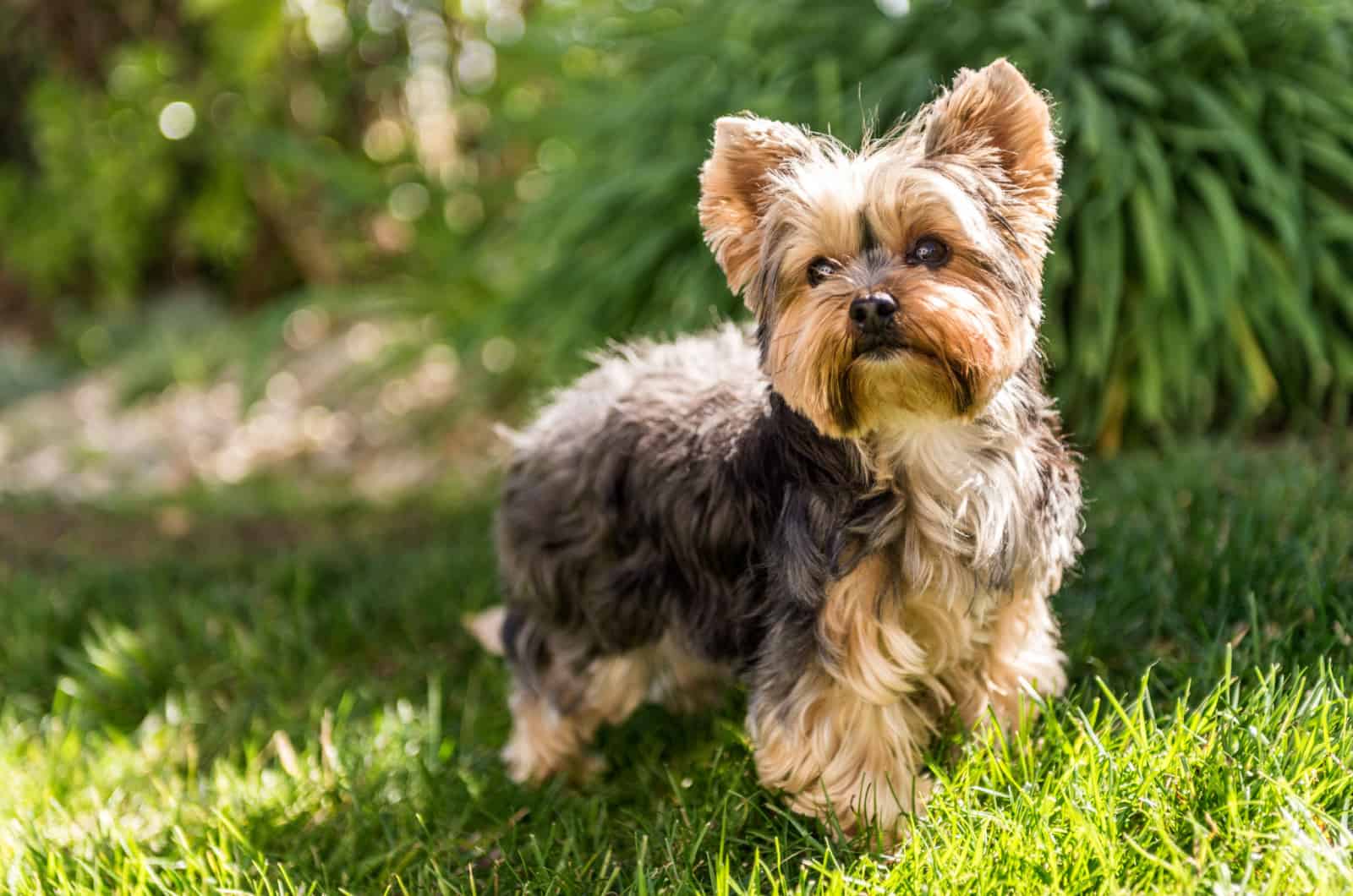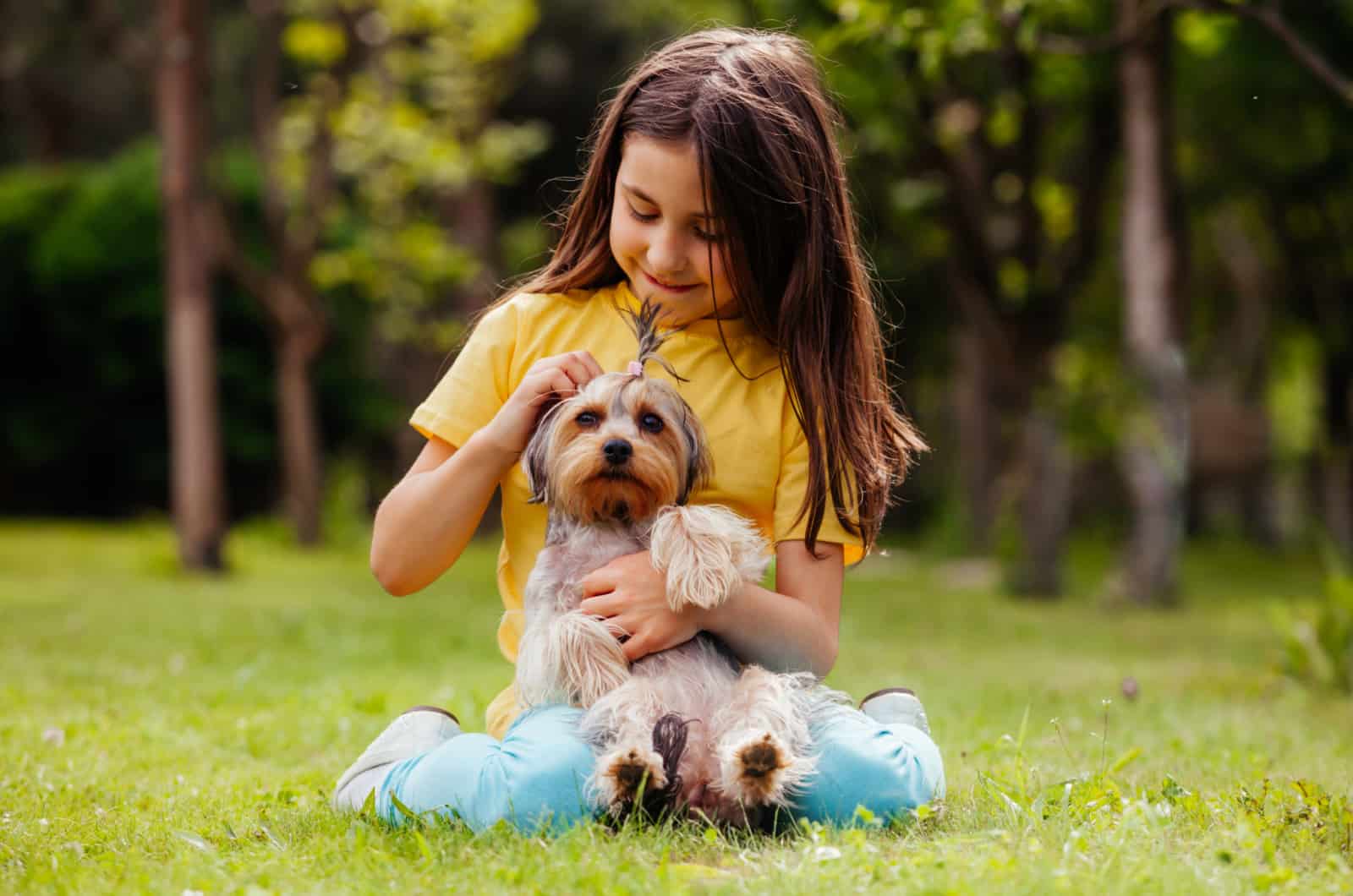Are you a fan of long-haired puppies that also happen to be excellent family members? Then, you’re in the right place! The Yorkshire Terrier, or popularly known as the Yorkie, is a small breed puppy that makes an amazing life companion, and it happens to be one of the funniest breeds in the world.
In order to raise a healthy Yorkie, you need to pay attention to several things, but the Yorkie growth chart is top priority on the list. These canines are very sensitive in terms of their size as the puppy itself doesn’t exceed seven pounds in weight.
There’s a pretty good chance that you might spoil your Yorkie puppy as this is a natural charmer that will melt your heart at all times. You might exceed your daily limit of treats and affect your puppy’s healthy growth.
Here are the tips for how to raise a healthy Yorkie puppy, with all the dos and don’ts in regard to its growth chart!
The Yorkie Growth Chart

The average size of every Yorkie puppy is six to seven pounds in weight, and eight to nine inches in height. In order to follow its growth, it would probably be a good idea to establish the Yorkie Growth Chart and monitor the growth of your puppy on a daily or weekly level.
In order to understand the Yorkie growth chart better, we will divide it into two parts. The first will be dedicated to the Yorkie’s weight, and in the second one, we will see what the standard height is of Yorkie puppies throughout life stages.
Let’s take a look!
The Yorkie Chart By Age
[table id=617 /]
As we can see, there are only a few changes when in the early stage of a Yorkie’s life. The growth goes slowly, week by week.
The Yorkie feeding chart is really important in this regard as proper feeding stimulates growth and helps your puppy develop properly. Now, let’s take a look at the height chart!
The Yorkie’s height chart by age
[table id=618 /]
In this chart, we see that the growth has more variations in the early stages than in the latter stages. The initial birth size will be a good estimate to predict the future puppy growth chart.
However, every Yorkie is a unique puppy, and its size can be relative. A general growth chart helps you compare the growth ratio of your dog and other small Yorkies, and to have a clear image of what a standard Yorkie puppy should look like throughout the stages.
Each of the three development stages (puppyhood, juvenile age, and adulthood) are equally important, and they have their own unique characteristics. It is crucial to know what things go hand in hand with a specific life stage, and how to contribute to your puppy’s overall development.
Furthermore, let’s take a brief look at a Yorkie’s life stages separately.
Yorkie Growth Stages Explained

In order to fully understand the Yorkshire Terrier Puppy’s growth, we need to focus on the dog’s weight and height throughout its life stages. There’s no clear, universal rule that determines the size of these puppies. All data is relative, and measured with a height and weight calculator.
Also, this is an estimate of purebred Yorkies, not Yorkie mixes. How big do Yorkies get depends exclusively on their bloodline, health, and lifestyle. Furthermore, there’s no clear rule that determines when Yorkies stop growing.
Some puppies stop growing when they reach ten or twelve months, while other puppies continue growing until they reach adulthood.
Birth To Three Weeks
This is probably the most sensitive life stage of Yorkie puppies. The first couple of weeks is also called the puppyhood stage, and it goes all the way to the juvenile stage, which starts at six months of age.
Mother’s milk is essential in this stage of life as puppies use it as a universal food that contains all of the needed ingredients for their growth. Yorkie owners should bear in mind that in this stage of life, puppies need a calm, nurturing environment.
Avoid bathing a Yorkie puppy during the first weeks of life as they are still undeveloped and sensitive. Keep these cute littermates warm and close to their mother. This is pretty much everything they need during the early puppyhood phase.
However, there is a high possibility that you will purchase the Yorkshire Terrier puppy at six to eight weeks of age as this is the age at which reputable breeders sell their puppies. They take care of their height and weight chart during the first weeks as they want to make sure that the puppy is healthy and well provided for.
AKC-registered Yorkie breeders are the best option, though!
Three to 12 Weeks

In this stage of life, Yorkie puppies have their eyes open and their coat color defined, and they are slowly starting to learn things.
This is an excellent period to potty train your puppy. Both female and male Yorkies have to be obedience trained at an early age as adult Yorkies that haven’t had much training can be stubborn.
However, most of this work will already be done by Yorkie breeders. That’s why it is crucial to pick the best ones in the business as there are numerous breeders who don’t pay as much attention to the Yorkie growth chart as needed.
These cute, teacup Yorkies are an intelligent dog breed that perfects tasks easily. That’s why Yorkies are quite popular in agility and conformation contests. By the twelfth week, they can be highly socialized and well-adapted to big crowds of people.
Yorkies are extremely social puppies, and their socialization training starts in this stage of life, too. Their coat is getting longer, their paw size is increasing, and there are significant changes in their overall growth chart.
The Yorkie growth chart slowly changes upward as puppies in the twelfth week are twice as big as when they were born. Dog training, alongside the best dog food for your Yorkie, is crucial as this is the phase in which Yorkie puppies benefit the most, both physically and mentally.
Three To Six Months
This stage of the Yorkie puppy’s growth is called late puppyhood. Yorkies are still far away from their adult size and adult weight, but their coat is pretty long, their teeth are developed enough to crunch kibble, and the puppies are getting more and more active.
This is the time to research the best dog food for your Yorkie puppy as the Yorkie weight chart highly depends on what and how much they eat. You don’t want to make your puppy overweight, especially in this stage of life.
Obesity doesn’t do good for the Yorkie breed, especially because of the fact that this is a small breed that doesn’t have as much activity as large dog breeds. The puppy’s weight has to be monitored daily, and the treats you give them have to be as healthy as possible.
Black and tan, black and gold, chocolate, and parti Yorkies are the most common types of this puppy in terms of coat color. The color is already recognizable in the late puppyhood stage, and it is most likely that it will stay like that in the latter stages.
Six To 16 Months

The juvenile phase is the last phase prior to adulthood in the Yorkie growth chart. As soon as your puppy turns six months of age, it is old enough to be spayed or neutered.
This is actually pretty favorable as the process of spaying/neutering neutralizes the possibility of displaying destructive behavior in the future.
If you’re wondering why your dog is acting weird, the answer might be that it has reached the sexual maturity phase! The juvenile phase is also a sensitive period of time as puppies are entering their puberty.
There are significant changes in the Yorkie growth chart during the juvenile phase. As the puppies are getting significantly bigger, they go through hormonal changes, and they seek more activity.
Even though they still haven’t reached their adult phase, Yorkies are pretty much done growing by the one-year mark. We can conclude that their physical growth positively correlates with their sexual maturity, but that doesn’t always have to be the case.
A dog, however, doesn’t meet its mental peak at this age. They still have a long way to go. However, as much as they grow, Yorkshire Terriers will preserve some of their baby traits. They will still enjoy taking an occasional nap on your lap, or they will crave cuddling.
Adulthood
Is this the current age of your Yorkie puppy? Then, you probably know that the current weight represents the adult weight of a Yorkie dog. Be careful, and don’t impact the size of your puppy negatively.
If you’re wondering how heavy your dog should be, go back to the Yorkie growth chart and make a comparison. Try to keep your puppy within the weight ratio, and take care of its feeding habits. The best time to feed your Yorkie once it reaches the adulthood phase is early in the morning.
The next time that is suitable for feeding is at noon. If you prefer three meals a day, then try to feed your puppy dinner at least three hours before bedtime.
After the puppy reaches sixteen months of age, it is considered as an adult. In this stage of life, your puppy is already up to seven pounds in weight, and eight to nine inches in height. They are mature enough, both physically and mentally, to be engaged in more exhaustive activities, such as long walks or agility training.
However, this is the phase in which the puppy doesn’t grow anymore. There are potential health problems you should be aware of, such as hypoglycemia and obesity. In order to maintain your puppy’s lifespan healthily, make sure that you take it for regular vet checkups.
How To Raise A Healthy Yorkie

The Yorkie growth chart is characterized by slow, but significant changes that contribute to the overall Yorkie’s development. The good part of the Yorkie puppy’s growth belongs to its bloodline and its hereditary traits.
However, there are some things that can impact the puppy’s growth, aside from its genetic predispositions. Here, we are especially referring to proper feeding, training, mental stimulation, regular vet exams, and spaying or neutering.
These are the things that actually set the price of a Yorkie puppy. If you’re wondering how much Yorkies cost, the answer will depend on whether the breeder implements all the aforementioned things.
Properly fed, trained, regularly checked by a vet, and mentally-stimulated Yorkies have a higher potential to be healthy throughout their entire life. The overall lifespan of Yorkie puppies is 11 to 16 years, which is quite high. In order to remain that way, you need to have these things implemented.
1. Proper Feeding
This is the first thing on the list that impacts the Yorkshire Terrier’s growth. Feeding can impact the overall growth of your puppy either positively or negatively. It depends on how well you establish the Yorkie feeding chart, and how often you stick to it.
Even though the Yorkie breed doesn’t qualify among the healthiest dog breeds in the world, they are pretty close to the top. They need a proper feeding chart in order to remain healthy. This means you should stay away from big portions of protein and processed carbohydrates.
Yorkies don’t need that much protein as they are not as active as other, larger breeds. The food needs to have a good representation of all macronutrients. The puppy needs three small meals a day that are three to four hours apart.
Obesity is the one thing you don’t want to see in your Yorkshire Terrier. These are extremely active puppies that love playing around the house or walking in the city. Obesity makes them inactive and disinterested in any sort of activity, and it leads to diabetes.
Hypoglycemic episodes are common in Yorkies that suffer from diabetes, and the recommendation is to visit a vet prior to the creation of the Yorkie feeding chart.
2. Training
There are several types of training you can give to your Yorkshire Terrier puppy. The first, and probably the most important, is early obedience training. Any postponement in obedience training can lead to possible stubbornness, which is quite destructive in a Yorkie puppy.
These are not the easiest dogs to potty train, nor to teach how to behave at their best. Despite their exquisite intelligence, Yorkie puppies can be extremely spoiled and badly behaved. Early obedience training implies learning basic puppy manners.
Another thing you can give to your puppy in this regard is early socialization. Use treats as positive reinforcement by rewarding your puppy when it shows good manners.
Yorkies love treats, and they will do anything to get them. Eventually, good behavior will become a pattern that doesn’t fade.
Training is crucial for improving the overall Yorkie growth chart. These puppies need moderate activities during the day in order to remain healthy. With proper training, they will start eating better, and their muscles will develop better.
Some breeders use puppy tools to improve the quality of training. This implies dog training collars, leashes, and puppy toys. Give this a try!
3. Mental Stimulation

Even though the Yorkshire Terrier doesn’t qualify among the top 20 smartest dog breeds in the world, this is still a very intelligent dog. This puppy learns new tricks without any problem, but it gets bored easily. The dog then seeks new ways of entertainment, and it is up to you to find a creative solution.
You don’t know how to mentally stimulate your puppy? Here are some tips that might help you. The first thing you can do is keep your pet busy. For instance, you can make your canine work for its food.
A little ‘‘food game’’ has proven many times to be the best solution for mental stimulation.
Furthermore, try to vocalize your attitude as much as possible. Name the toys, and speak loudly. That way, your puppy will understand things easier. Also, you can impose a dog puzzle game or try to teach some new tricks that you didn’t bring up in the past.
Dogs love creativity, and this especially refers to small breeds. They are the kings of households, and they love small, tricky challenges that you provide inside the house. This also goes for Yorkies. These intelligent, furry canines will do anything to keep you engaged!
4. Regular Vet Exams
Any reputable breeder will tell you that regular vet exams and vet checks are crucial in the overall Yorkie growth chart. When you take your puppy to a vet regularly, you decrease the possibility of it developing severe health conditions.
Acting timely is crucial in certain situations, especially if we talk about major health problems that your puppy can face. This goes for injuries, heart problems, and patellar luxation, which is quite common in a Yorkshire Terrier.
Not treating these conditions means leaving your puppy high and dry. They won’t be able to develop properly, and repercussions will probably be deadly.
Responsible owners will have their vet exams scheduled and followed. Aside from them, it is recommended to keep an eye on your puppy’s feeding chart. Yorkies can suffer from kidney stones, so dog food for urinary health is highly recommended in this regard.
Obesity is another long-term problem that can affect your Yorkshire Terrier. This issue can lead to diabetes and severe episodes of hypoglycemia. In order to avoid this major condition, consult your vet about the best dog food for your Yorkie puppy.
5. Spaying Or Neutering
You may want to consider spaying or neutering in the juvenile phase of your puppy’s life. The Yorkie growth chart changes significantly after the juvenile phase as the puppy becomes more sexually active, and will display unusual dog behavior if kept indoors.
In order to avoid the possibility of self-destruction or aggression, spaying or neutering is something you need to consider. Spayed or neutered canines show more affection, and research shows that they are generally healthier than puppies that are not subjected to this treatment.
The best possible solution for avoiding the phenomenon of dogs humping the air is to subject them to this medical procedure. It doesn’t cost a fortune – it is quite affordable. It will provide your puppy with a lifetime of happiness, health, and mental stability.
FAQs

1. At What Age Do Yorkies Reach Their Full Size?
In terms of physical development, Yorkies reach their full size by the end of the first year of their life. This is common for all Yorkie puppies, but it doesn’t always have to be the case. Some puppies develop even earlier as their genetics allow them to grow faster.
However, there are some puppies that develop after the first twelve months. Usually, the Yorkie’s overall growth ends by the end of the sixteenth month. This is the official start of their adult phase, and the time when they reach their mental peak.
One thing that is important to know is that Yorkie puppies reach their puberty much earlier. They reach sexual maturity by the end of the 10th month. That’s why it is really important to consider spaying or neutering between the sixth and the eighth month.
This is perfect timing because of the fact that once they enter puberty, sexually mature dogs can display unwanted behavior. This includes aggression, self-destruction, and even anxiety. Sexual maturity and the end of the Yorkie puppy’s growth don’t correlate.
2. What Is The Average Weight For A Full-Grown Yorkie?
Most Yorkie breeders claim that the ideal weight of a Yorkshire Terrier is between six and seven pounds.
This is one of the smallest dog breeds in the world, right next to Chihuahuas. Many refer to Yorkies as toy dogs as they can, indeed, fit into your pocket.
However, the size of a Yorkie puppy can either go up or down a few pounds, give or take. Anything beyond that will be considered as obesity, which is not quite favorable for Yorkie puppies. These puppies are not the most active dogs in the world as they are bred for indoor life.
That’s why it is crucial to take care of their feeding chart, and to provide the best dog food for them. Yorkies get overweight easily, and this is something you don’t want in your canine.
Obese Yorkie puppies are disinterested in any sort of activity, which is something that is pretty uncommon for this breed.
3. What Type Of Food Should You Feed A Yorkie?
The best dog food for a Yorkie puppy is food that contains healthy fats and protein. However, you need to be careful when feeding this puppy as they don’t need as much protein as large dog breeds. This is a moderately active dog that requires an hour of exercise during the day.
They need the proper representation of macronutrients in their feeding chart, as well as adequate green vegetables that improve their digestive system.
The worst dog food brands on the market are highly unfavorable, and may hurt your little canine. Always check the food you give to your Yorkshire Terrier, and consult a veterinarian.
4. How Much Does A Yorkie Weigh At 8 Weeks Old?
The average weight of a Yorkshire Terrier at eight weeks of age is 1.5 to 2 pounds. This is the average weight according to the estimated weight of a Yorkie puppy. However, this doesn’t always have to be the case.
The Yorkie growth chart sometimes varies based on genetics, health issues, and lifestyle.
Anemia can be a severe condition that causes improper development in a Yorkie. It can also be the reason why an eight-week-old puppy breathes fast while sleeping. If your puppy suffers from anemia, then a vet examination is a must.
However, it is highly unfavorable for your puppy to be under the 1.5-to-2 ratio. You need to measure the weight of your puppy regularly, and consult your vet in case something is wrong.
Conclusion
The Yorkie growth chart is a good indicator of your puppy’s future growth. The estimated growth is measured by using a height and weight calculator. The puppy calculator generates the most important physical features of a puppy, and it helps you predict its future growth.
However, each Yorkie puppy has its own relative path. The standard deviation can be a few pounds either up or down, but anything below that is concerning.
Yorkie puppies are a toy breed that can gain weight easily, but they can also be underdeveloped. Therefore, daily monitoring of your puppy’s growth is a good choice!
Read more:
• 9 Best Yorkiepoo Breeders In The U.S.
• How To Measure A Dog’s Height The Right Way
• Are Yorkies Good With Kids: A Perfect Family Pet Or Not?
